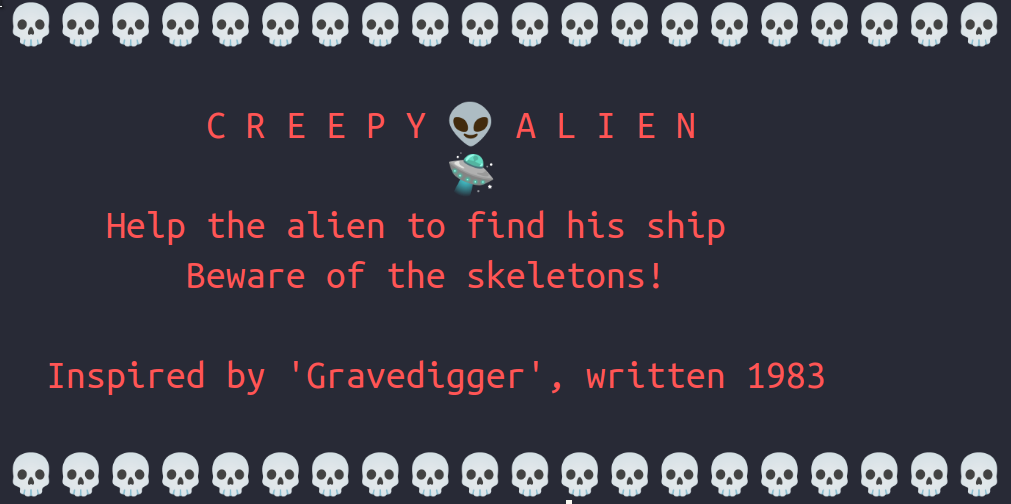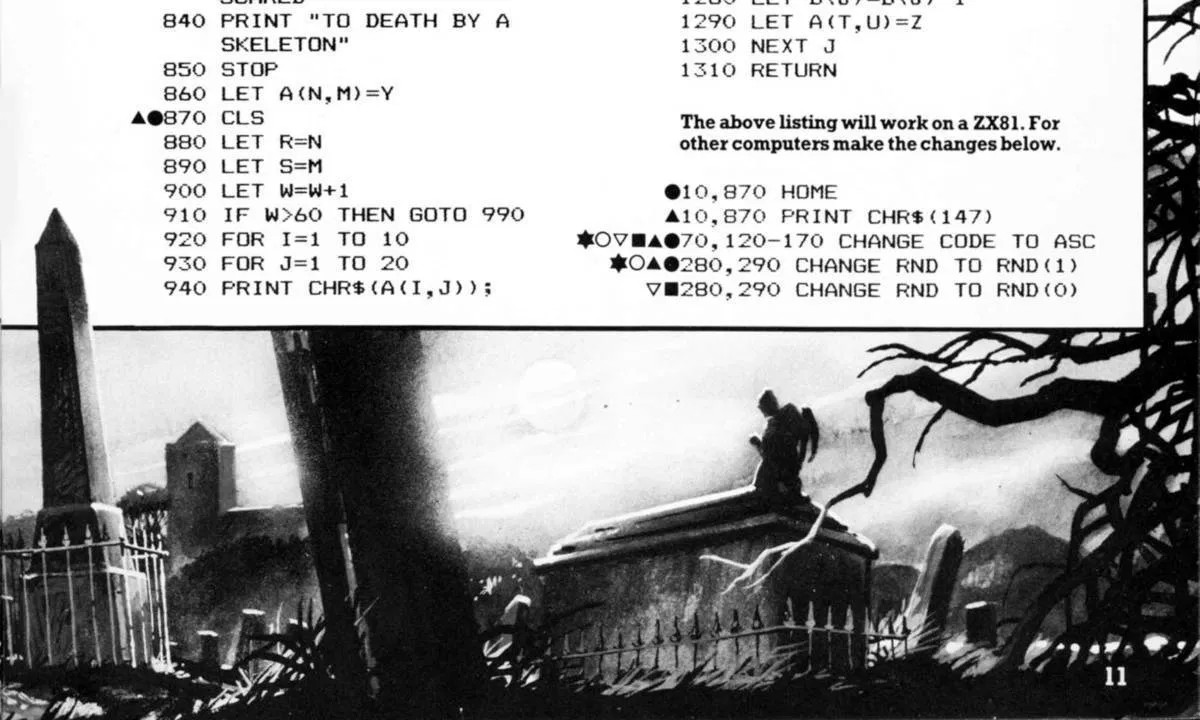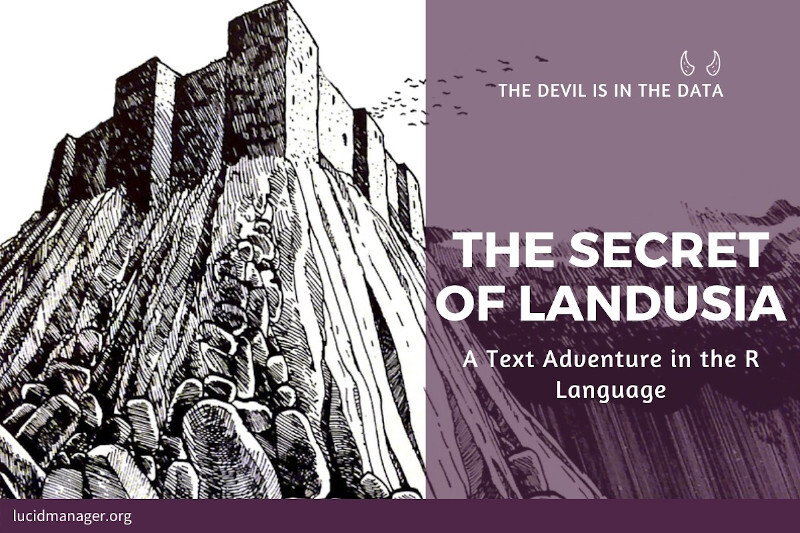
Celebrate Halloween with Creepy Computer Games in R

Peter Prevos |
1125 words | 6 minutes
Share this content
Halloween is upon us once more and who ever said that data science can't be scare. This article translates the Gravedigger game from the 1983 Creepy Computer Games book to celebrate Halloween. This article is part of my series on gaming with the R language.
In the 1980s I spent my time writing code on my 8-bit ZX81 and Atari computers. I learnt everything I know about programming from copying and modifying printed code listings from books with computer games. The games in these books are mostly simple text-based games. The authors gave them enticing names, often imaginatively illustrated to visualise the virtual world they represent. A line and a dot become a game of tennis, and a computer that was able to play Tic Tac Toe seemed like your machine had come alive.
Let's step into the creepy world of computer games as imagined by Usborne Publishing.

Creepy Computer Games - Gravedigger
Alan Ramsey's Gravedigger is a typical example of the games of the early days of home computing. You can download the original book for free from the publisher's Google drive. The Gravedigger listing starts on page 10. The lyrical description of the game provides the instructions:
It's dark and windy—not the kind of night to be lost in a graveyard, but that's where you are. You have until midnight to find your way out. Skeletons lurk in the shadows waiting to scare you to death should you come to close. You can dig holes to help keep them away but digging is tiring work and you cannot manage more than five in one game. You have to be careful not to fall down the holes you have dug. Grave stones (marked
+) and the walls of the graveyard (marked:) block your way. The holes you digs are markedO, you are*and the skeletons areX. See if you can escape.

Creepy Alien
Roland Krasser has developed vastly improved version of the code and published the Creepy Alien game on CRAN.
install.packages("creepyalien")
creepyalien::creepyalien()
The Gravedigger code
I translated the BASIC code as close to the original as possible. I changed some of the variable names because, in BASIC, single variables and vectors can have the same name and names of character vectors end in a $ character.
The game is quite tricky, and I have only managed to escape the graveyard once. It looks like the likelihood of success very much depends on the random distribution of the graves. Perhaps we need some machine learning to optimise strategy.
I leave it up to you to deconstruct the program and safely work your way through the graveyard.
Happy Halloween!
indicate different versions for various dialects of the BASIC language.

## Creepy Computer Games
## Reynold, Colin and McCaig, Rob, Creepy Computer Games (Usborne, London).
## https://archive.org/details/Creepy_Computer_Games_1983_Usborne_Publishing/
## Gravedigger by Alan Ramsey
## Initiate board
A <- matrix(ncol = 20, nrow = 10)
A[, ] <- " "
## Starting variables
W <- 0 # Move number
X <- 5 # Remaining holes
death <- 0 # Game over?
## Initiate pieces
Y <- "*"
B <- "+"
C <- "O"
D <- ":"
E <- "X"
Z <- " "
## Draw board
## Add borders
A[c(1, 10), ] <- D
A[, 1] <- D
A[1:8, 20] <- D
## Add graves
for (i in 1:20){
A[floor(runif(1) * 7 + 2), floor(runif(1) * 15 + 3)] <- B
}
## Starting positions
## Player
M <- 2
N <- 2
A[N, M] <- Y
## Skeletons
S <- c(4, 19, 3, 19, 2, 19)
## Game play
repeat{
## Position skeletons
for (J in seq(1, 5, by = 2)) {
A[S[J], S[J + 1]] <- E
}
W <- W + 1 ## Move counter
if (W > 60) {
print("The clock's struck midnight")
print("Aghhhhh!!!!")
break
}
## Print board
v <- paste(as.vector(t(A)), collapse = "")
for (i in 1:10)
print(substr(v, (i - 1) * 20 + 1, (i - 1) * 20 + 20))
## Enter move
A1 <- toupper(readline(paste0("Enter move ", W, " (You can go N, S, E or W): ")))
## Move player
T <- N
U <- M
if (A1 == "N") {
T <- N - 1
} else if (A1 == "E") {
U <- M + 1
} else if (A1 == "S") {
T <- N + 1
} else if (A1 == "W") {
U <- M - 1
}
## Collision detection
if (A[T, U] == D | A[T, U] == B) { # Edge or grave
print("That way's blocked")
} else if (A[T, U] == C) { # Hole
print("You've fallen into one of your own holes")
break
} else if (A[T, U] == E) { # Skeleton
death <- 1
} else if (T == 9 & U == 20) { # Escaped
print("You're free!")
print(paste0("Your performance rating is ",
floor((60 - W) / 60 * (96 + X)), "%"))
break
} else if (death == 1) {
print("Urk! You've been scared to death by a skeleton.")
break
} else if (A[T, U] == Z) { # Player can move
## Move player and dig hole
A [N, M] <- Z
if (X != 0) {
B1 <- toupper(readline("Would you like to dig a hole (Y or N): "))
if (B1 == "Y") {
X <- X - 1
A[N, M] <- C
}
}
N <- T
M <- U
A[T, U] <- Y
## Move skeletons
for (J in seq(1, 5, by = 2)) {
## Store skeleton position in temp variable
P <- S[J]
Q <- S[J + 1]
if (any(c(A[P + 1, Q], A[P - 1 , Q], A[P, Q - 1], A[P, Q + 1]) == Y)) {
death <- 1
} else
{
## Move skeletons
if (A1 == "S" & A[P + 1, Q] == Z){
S[J] <- S[J] + 1 # Follow player
A[P, Q] <- Z
} else if (A1 == "N" & A[P - 1, Q] == Z){
S[J] <- S[J] - 1 # Follow player
A[P, Q] <- Z
} else if (A1 == "E" & A[P, Q - 1] == Z & M < Q){
S[J + 1] <- S[J + 1] - 1 # Move towards player
A[P, Q] <- Z
} else if (A1 == "E" & A[P, Q + 1] == Z & M > Q) {
S[J + 1] <- S[J + 1] + 1 # Reverse direction
A[P, Q] <- Z
}
}
}
}
}Share this content


